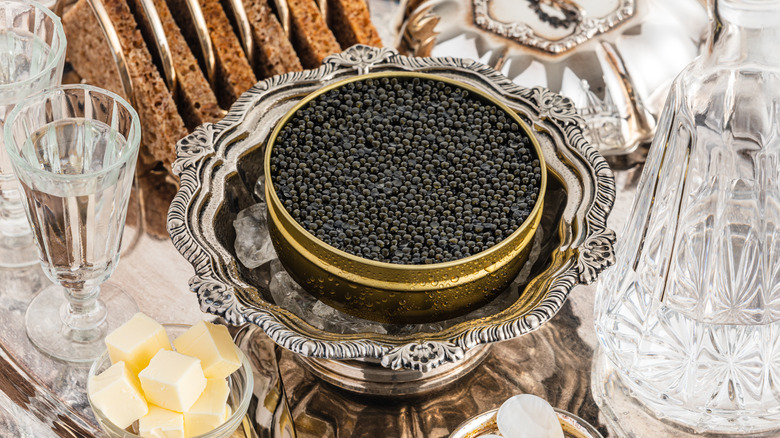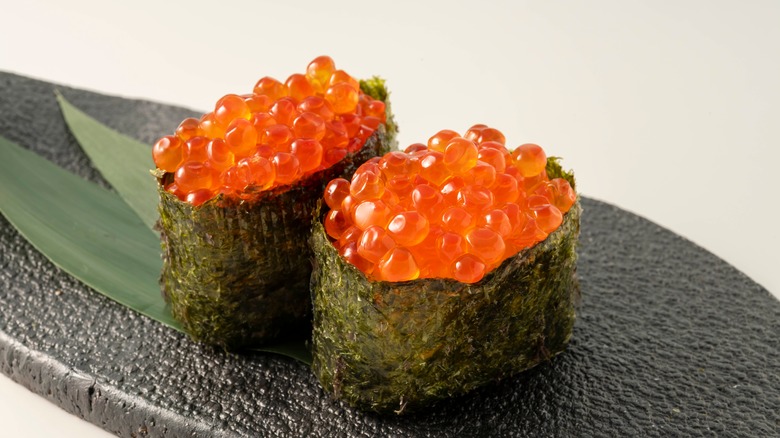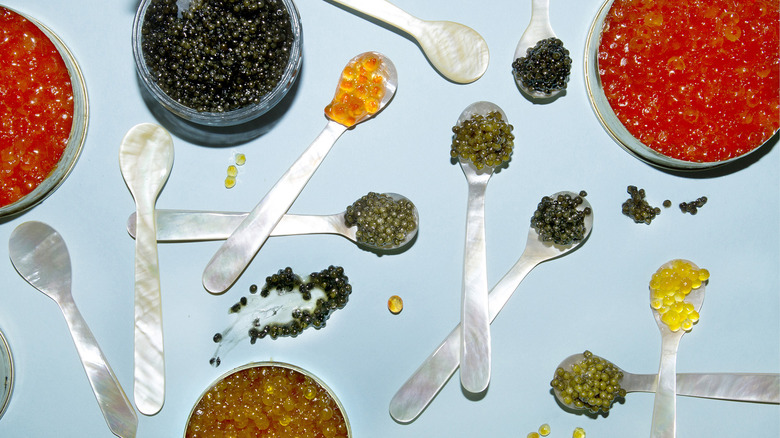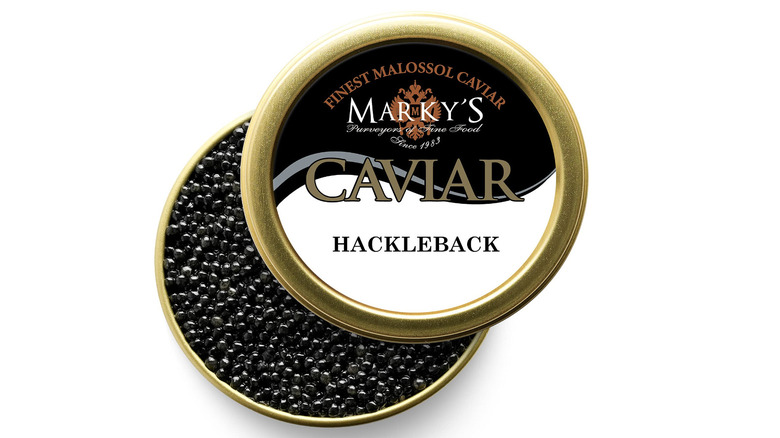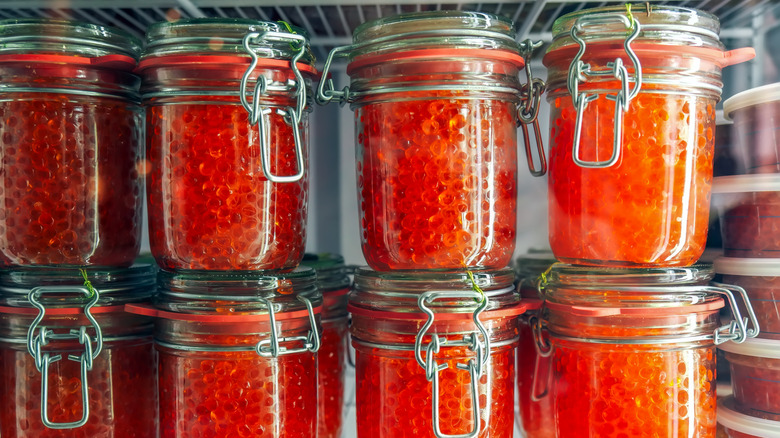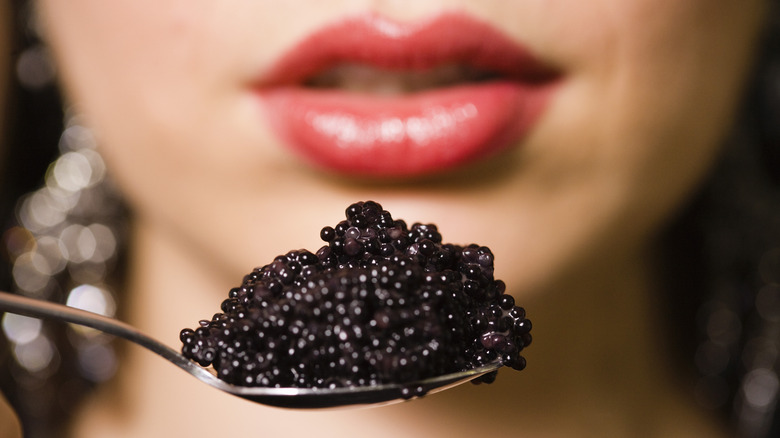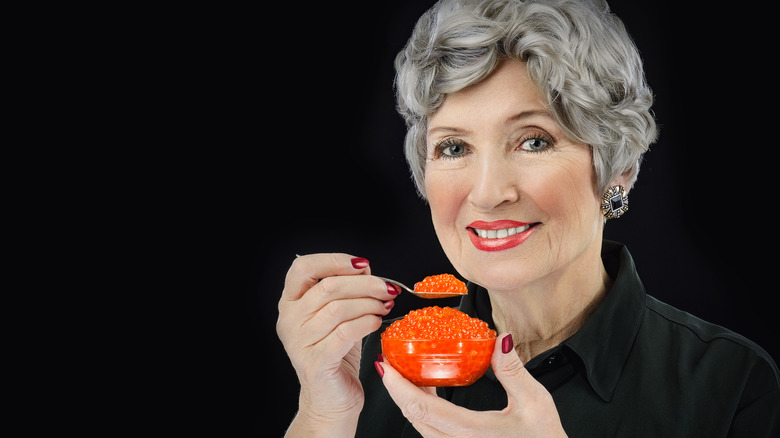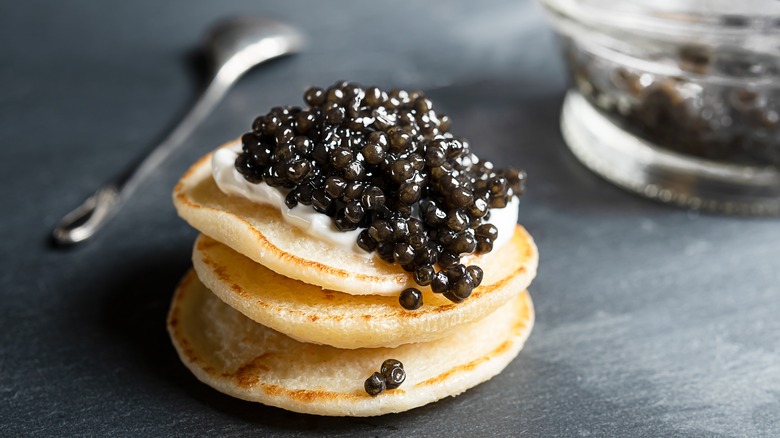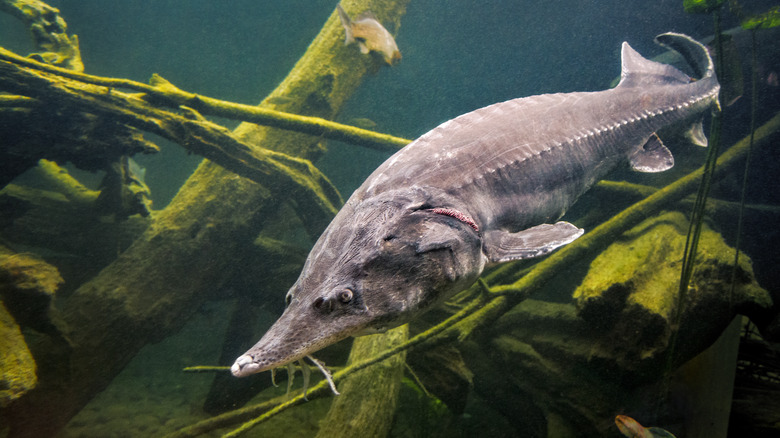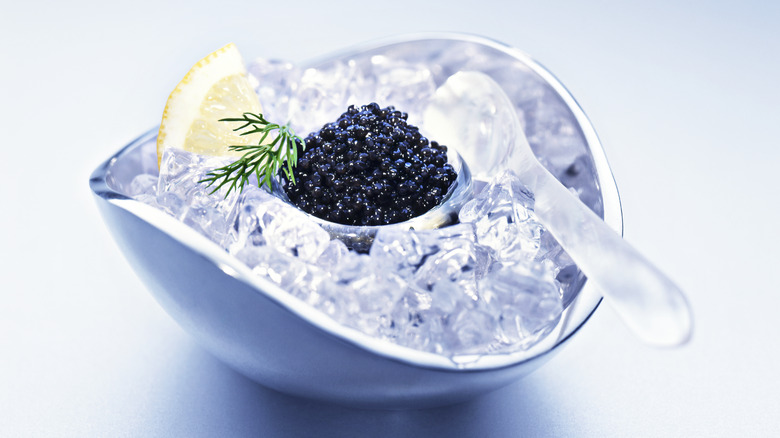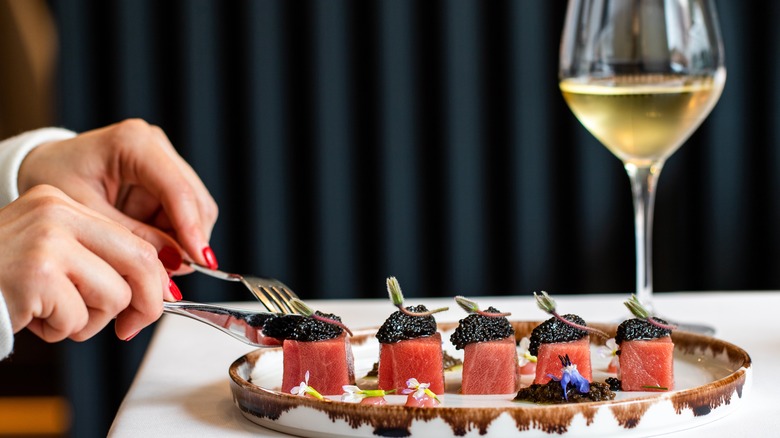False Facts About Caviar You Thought Were True
We may receive a commission on purchases made from links.
Revered as a delicacy, caviar is the unfertilized, salt-cured roe of sturgeon fish. Caviar is often described as mildly salty, with a rich, buttery flavor that varies depending on the type of sturgeon fish it's harvested from and its habitat as well as the method of preparation. The size, color, and texture of the roe also vary, allowing connoisseurs to enjoy the gourmet item in different forms.
Both the rarity of sturgeon fish and the labor-intensive process involved in harvesting caviar have contributed to the product's high price point. More specifically, overfishing has led to a decline in wild sturgeon populations, placing many of the fish species on the endangered list. In response to this crisis, sustainable farming practices have been developed that allow for the extraction of sturgeon eggs without killing the fish. This is a welcome development since the growing international caviar market is estimated at nearly $373 million this year and projected to be valued at more than $547 million by 2029, according to market research firm Mordor Intelligence.
Despite its steep price and luxury status, caviar is the subject of many myths. Not to worry, however, because we are here to separate fact from fiction. Curious to learn more? Keep reading!
False: All fish eggs are caviar
Fish roe and caviar can look similar to the untrained eye, but they have very distinct characteristics that set them apart beyond the substantial price difference. While the term "caviar" is sometimes used generally to describe fish eggs, a product officially classified as caviar has to meet specific criteria. Firstly, true caviar comes exclusively from the sturgeon family of fish. It then has to undergo malossol, which is a salt-curing process.
Although sometimes also referred to as caviar, roe from other fish such as salmon, trout, or cod is simply that — roe. Furthermore, roe can also be harvested from a range of aquatic species such as scallops, squid, or lobsters. While it's possible to salt-cure any roe like caviar, this process is optional.
Belonging to the Acipenseridae family, sturgeon fish have been around for some 200 million years, making them one of the oldest surviving fish groups. These elongated fish are notable for their striking appearance, characterized by rows of bony plates rather than scales and a heterocercal tail similar to that of sharks. Today, these remarkable creatures can be found in the waters of the Caspian and Black seas as well as in North America and Europe.
False: All caviar tastes the same
Caviar can be a pricey business. As such, many people may not have had the opportunity to taste different types of caviar, leading to a limited understanding of its different incarnations and flavors. In fact, the term "caviar" is often used broadly, without regard to the various species of sturgeon fish it comes from or the regions of its harvest. In reality, there are 27 species of caviar-producing sturgeon, each one offering its own unique egg size, flavor, and texture.
The caviar produced by three sturgeon species stands out as the most highly regarded and expensive. The Beluga sturgeon is prized for its large, gray eggs that offer a subtle, nutty flavor and a buttery texture, making it one of the most sought-after and expensive types of caviar. The Osetra sturgeon produces medium-sized eggs with a nutty yet somewhat fruity taste, varying in color from brown to gold. Then there's the Sevruga sturgeon, which yields smaller and crunchy pearls with a bold and buttery flavor. But don't stop there. Mashed spoke with one expert who detailed the differences from among seven types of caviar.
False: Caviar has to be expensive
While caviar is normally considered a luxury item, not all caviar is prohibitively expensive. The cost of caviar depends on several factors, including the species of fish, the region it comes from, and the harvesting method. Some of the most expensive caviar comes from the Beluga, Osetra, and Sevruga species, which are found primarily in the Caspian Sea. Prices for Beluga caviar can reach $250 per ounce, whereas Osetra and Sevruga caviars, while still expensive, may be slightly more affordable, with prices ranging between $100 to $120 per ounce. Of course, all of these price tags can fluctuate depending on product quality and specific sourcing.
Despite the popular belief that caviar is a luxury reserved only for the wealthy, the delicacy needn't cost an arm and a leg — well, sort of. The caviar market is pretty diverse, catering to various tastes and budgets. One of the more accessible products is Hackleback caviar, a treat that offers an alternative to the high-priced varieties of caviar traditionally sourced from the Caspian Sea. Harvested in the United States, Hackleback caviar is available on Amazon for just under $50 an ounce.
The caviar market also includes other budget-friendly options, such as Paddlefish and Bowfin "caviar." Although these fish don't belong to the sturgeon family, their roe is similar in texture and taste to sturgeon caviar. You could also try caviar substitutes, like ikura or soy pearls, when you don't want to pay for the expensive stuff.
False: Caviar shouldn't be stored in the fridge
Despite being salted, caviar is a highly perishable delicacy and requires careful handling and storage conditions to maintain its freshness and taste. To ensure optimal quality, tins of caviar should be stored between 28 and 32 degrees Fahrenheit. Since room temperature ranges between 68 and 76 degrees Fahrenheit, unless you live in a very cold climate, storing cans of caviar in your kitchen pantry is probably out of the question.
To preserve caviar as long as possible, it's best to store it in the coldest part of the refrigerator, which often is the back of the bottom drawer. If unopened and stored in optimal conditions, caviar usually lasts between three and five weeks. Once opened, however, caviar should be consumed within three days. To minimize oxidation, place plastic wrap between the caviar and the lid of the storage container. While freezing caviar isn't recommended, this doesn't apply to roe from fish such as salmon, trout, or whitefish, which can be kept in the freezer for up to 12 months.
False: Caviar is unhealthy
Let's face it. Many of our favorite foods aren't all that great for our health. While delicious, fried chicken is high in unhealthy fats and calories. The same goes for treats such as ice cream and donuts, which are loaded with sugar. Some people put caviar into the same category. But if eaten in moderation, caviar can actually be very healthy. While relatively high in sodium and cholesterol, the gourmet item packs a nutritional punch, being a superb source of omega-3 fatty acids and vitamin B12.
The combination of the nutrients found in caviar has several health benefits. Omega-3 fatty acids are important for maintaining heart health, lowering blood pressure, boosting good cholesterol, and supporting the immune system. Vitamin B12 plays a crucial role in preserving the health of nerve cells and assists in the creation of DNA and red blood cells, thereby lowering the chances of developing anemia. Caviar also contains vitamins A, D, and E as well as calcium, which support overall health and well-being.
False: Caviar should be chewed and eaten at room temperature
Given that we chew most of our food, it's only natural to assume that caviar can be consumed in a similar way. The bigger question, though, is whether you should chew caviar. Just like it's ill-advised to over-chew oysters — a slight chew or two is enough to release their subtle flavors — caviar too benefits from a gentle approach. Instead of breaking them with your teeth, let the caviar pearls sit in your mouth, rolling them around with your tongue to release all of their flavors.
Apart from the way it's consumed, it's vital to eat caviar at the right temperature. Ideally, caviar should be served chilled, between 26 and 34 degrees Fahrenheit, as this is the best way to showcase its delicate texture and nuanced flavors. Serving caviar too warm can alter its flavor and make it mushy. Conversely, serving the beads too cold can mute their subtle flavors. To achieve the perfect temperature throughout the dining experience, some recommend that caviar should be served over crushed ice.
False: Caviar has always been a luxury
Historically, caviar wasn't always the premium, expensive delicacy it's recognized as today. Its status has evolved over time, just like with lobster, which was once considered food for the poor. Sturgeon fish were abundant in the 1900s, making them a practical source of nutrition for the masses. Indeed, during that era, the meat of the sturgeon fish was valued more highly than its roe. The director of the short documentary "Caviar Dreams," Brian Gersten explained caviar's low value in an interview with Forbes, saying, "At the turn of the century, sturgeon were so prevalent in the U.S. that caviar was served in saloons for free essentially playing the role of modern day bar nuts."
So what's changed? Overfishing and the subsequent dwindling number of sturgeon fish led to a steep rise in prices. Today, caviar's high price point reflects not just the taste and texture of the delicacy itself, but also the intricate and time-consuming process of its production. For instance, it takes female sturgeons between eight and 20 years to reach the age when they can produce roe, and even at that point, their eggs cannot be harvested annually.
False: Caviar should be served alongside strong flavors
No matter how much you may be tempted to use caviar as a garnish for your culinary endeavors, pairing these aquatic pearls with intense flavors could detract from the enjoyment. This is because the value of caviar lies in its subtlety and complexity. Introducing any bold flavors into the mix can overshadow caviar's delicate balance of buttery, nutty, and slightly salty notes.
While many believe that caviar is best enjoyed on its own, others prefer serving the delicacy with mild accompaniments. Some of the traditional pairings used to showcase caviar's unique qualities include blinis (small Russian pancakes), crispy bread, unsalted crackers, and even baked potatoes and boiled eggs. Similarly, caviar is sometimes served with mild creams such as crème fraîche, cream cheese, or sour cream to enhance its texture and taste. While caviar can be garnished with fresh herbs, overseasoning the pearls can detract from their subtle and unique flavors.
False: The process of collecting caviar always kills the fish
Traditionally, harvesting caviar has involved killing the fish to extract its eggs. While this method is still used today, it's gradually being replaced by more ethical practices that aim to protect sturgeon populations. This shift is particularly significant because sturgeons face the threat of extinction from overfishing. In the U.S. alone, the Endangered Species Act lists all five species of the Atlantic sturgeon as either endangered or threatened.
Pioneered by German scientist Angela Köhler, the vivace method of roe extraction involves carefully massaging the eggs out of the fish. Once retrieved, the roe is washed in a mixture of water and calcium to ensure that it doesn't lose its texture. Prior to their eggs being harvested, sturgeon fish are injected with a hormone that detaches the roe from the membranous sac, making it easier to remove. Not just more humane, the vivace method is also more financially sound, as highlighted by Köhler in an interview with NPR. "It doesn't make much sense to take a fish that needs seven or eight years to mature and then, when it has its first eggs, kill it," she explains.
False: Caviar should be served with silver utensils
Silver cutlery can add a sense of occasion and elegance to any dining experience. However, when the star of the show is caviar, you may want to reconsider your options. This is because silver can react with the caviar, leading to an undesirable metallic taste. This also goes for other metallic utensils, such as nickel, aluminum, and bronze. While caviar is usually packaged in metallic tins, these are lined with a non-reactive coating to ensure that the pearls don't come into direct contact with the metal and prevent any potential chemical reactions caused by oxidation.
So, if silver and metal are a no-no when it comes to caviar, how should this epicurean delight be served? When dishing out caviar, it's best to use utensils made from non-reactive materials. Traditionally, caviar has been served with mother-of-pearl spoons, which are fashioned from the inner layers of mollusk shells such as oysters and abalones. Caviar has also been served in the past on ivory and bone, although we can't recommend these materials since illegal poaching isn't our jam. While not as luxurious, wooden, plastic, or even glass utensils can be used in a pinch to serve your caviar.
False: Caviar shouldn't be paired with wine
It comes as no surprise that caviar is traditionally accompanied by vodka, given the prized food's roots in the countries surrounding the Black and Caspian seas such as Ukraine and Russia. The crisp and neutral taste of chilled vodka is indeed a perfect counterbalance to the rich, salty nuances of caviar. In the same vein, champagne is also a favored pairing for caviar. The slightly acidic qualities of champagne offer a delightful contrast to caviar's mildly salty taste and silky texture.
Despite tradition, an increasing number of caviar enthusiasts are discovering that the depth and variety of white wines can also complement the prized pearl's unique flavor profile. That said, pairing caviar with red wine isn't advised due to its high tannins and bold flavors, which can easily overshadow caviar's delicate flavor. White wine, on the other hand, goes perfectly with caviar thanks to its typically lighter body, higher acidity, and subtler flavor profiles. Ideally, opt for a chilled drop that's slightly fruit-forward and not overly dry.
